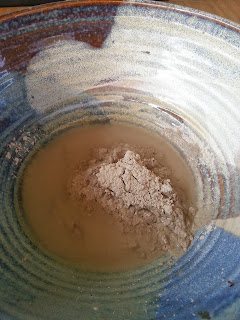In returning to an old question I had asked about tow, Cennini has the following to say on preparing gesso grosso:
'CLXIX How to Model Crests or Helmets.[211]
(after making the leather base)... Then take some of the regular size for gessoing, and size it two or three times. Then take some gesso grosso ground with size, and mix in some beaten tow, and get it stiff, like a batter; and put on this gesso, and rough it in, giving it any shape of man, or beast, or bird, which you may have to make, getting it as like as you can. This done, take some gesso grosso ground with size, liquid and flowing, on a brush, and you lay it three or four times over this crest with a brush.
1. "...regular size for gessoing..." As discussed in an earlier post, rabbit hide glue was not listed as the most common in use during this time period. It is, however, the most readily available form now. I will use it for this project and investigate other alternatives for future projects, to compare results.
2. "...size it two or three times..." This could mean 'apply hide glue size to the outside of the leather base in two or three coats.' We often apply a coat of glue as a sealer to woodwork or leatherwork projects, to give better coverage of outer coats of paint. This may help to attach the plaster layer.
3. "...Then take some gesso grosso ground with size..." We are going to use commercially available Plaster of Paris for our gesso grosso base. Since our plaster comes pre-ground in powdered form, rather than in blocks like Cennini had to deal with, we can go right ahead and mix in some powdered hide glue. He does not provide quantities or ratios. The text only implies that the size proportion is smaller than the plaster proportion.
4. "...and mix in some beaten tow..." I have found a few relevant descriptions for tow.
"n. Coarse broken flax or hemp fiber prepared for spinning....
...[Middle English, possibly from Old English tow-, spinning (in tow-cræft, spinning craft, spinning)."
|
"tow /təʊ/ N
- the fibres of hemp, flax, jute, etc, in the scutched state
- synthetic fibres preparatory to spinning
Etymology: Old English tōw; related to Old Saxon tou, Old Norse tō tuft of wool, Dutch touwen to spin"
1.
the fiber of flax, hemp, or jute prepared for spinning by scutching.
2.
the shorter, less desirable flax fibers separated from line fibers in hackling...
...Origin: 1300-1350; Middle English;
Old English tōw- (in tōwlīc pertaining to thread, tōwhūs spinning house);
akin to Old Norse tō wool
Origin: 1425-1475; Late English (Scots);
Old English toh- (in tohlīne towline); cognate with Old Norse tog towline."
This suggests that if I take some rope made from the most common material of 1440, being either flax, hemp or jute, and cut very small fibres up to mix into the plaster, I can use this to "...mix in some beaten tow..." I suppose it would be possible to use unspun flax or jute from another source, too.




























